
Elba is a Mediterranean island in Tuscany, Italy, 10 km (6.2 mi) from the coastal town of Piombino on the Italian mainland, and the largest island of the Tuscan Archipelago. It is also part of the Arcipelago Toscano National Park, and the third largest island in Italy, after Sicily and Sardinia. It is located in the Tyrrhenian Sea about 50 km (30 mi) east of the French island of Corsica.

Pianosa is an island in the Tuscan Archipelago in the Tyrrhenian Sea, Italy. It is about 10.25 km2 (3.96 sq mi) in area, with a coastal perimeter of 26 km (16 mi).

Portoferraio is a town and comune in the province of Livorno, on the edge of the eponymous harbour of the island of Elba. It is the island's largest city. Because of its terrain, many of its buildings are situated on the slopes of a tiny hill bordered on three sides by the sea.
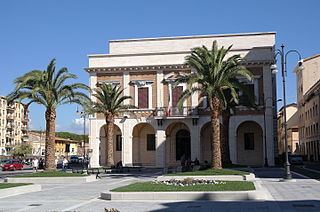
The province of Livorno or, traditionally, province of Leghorn, is a province in the Tuscany region of Italy. It includes several islands of the Tuscan Archipelago, including Elba and Capraia. Its capital is the city of Livorno. When formed in 1861, the province included only Livorno and Elba Island. It was extended in 1925 with land from the provinces of Pisa and Genoa. It has an area of 1,211 square kilometres (468 sq mi) and a total population of 343,003 (2012). The province contains 19 comuni. The coastline of the area is known as "Costa degli Etruschi".

The Tuscan Archipelago is a chain of islands between the Ligurian Sea and Tyrrhenian Sea, west of Tuscany, Italy.

Populonia or Populonia Alta today is a frazione of the comune of Piombino. As of 2009 its population was 17. It is one of I Borghi più belli d'Italia. Populonia is especially noteworthy for its Etruscan remains, including one of the main necropolis in Italy, discovered by Isidoro Falchi.

The State of the Presidi was a small territory on the Tuscan coast of Italy that existed between 1557 and 1801. It consisted of remnants of the former Republic of Siena—the five towns of Porto Ercole and Porto Santo Stefano on the promontory of Monte Argentario, as well as Orbetello, Talamone and Ansedonia—and their hinterland, along with the islet of Giannutri and the fortress of Porto Longone on the island of Elba.

The Lordship of Piombino, and after 1594 the Principality of Piombino, was a small state on the Italian peninsula centered on the town of Piombino and including part of the island of Elba. A vassal of the Kingdom of Naples associated with the State of the Presidios and a territory of the Holy Roman Empire formed from the remnants of the Republic of Pisa, it existed from 1399 to 1805, when it was merged into the Principality of Lucca and Piombino. In 1815 it was absorbed into the Grand Duchy of Tuscany.
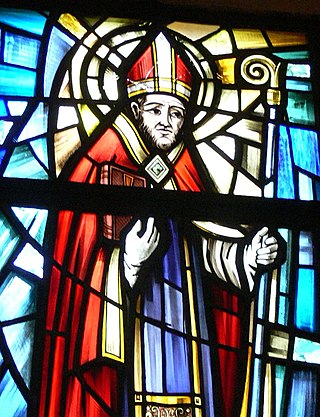
Cerbonius was a bishop of Populonia during the Barbarian invasions. Pope Gregory I praises him in Book XI of his Dialogues.

Jacopo III Appiano, VI Lord of Piombino was an Italian nobleman.
The 215th Coastal Division was an infantry division of the Royal Italian Army during World War II. Royal Italian Army coastal divisions were second line divisions formed with reservists and equipped with second rate materiel. They were often commanded by officers called out of retirement.
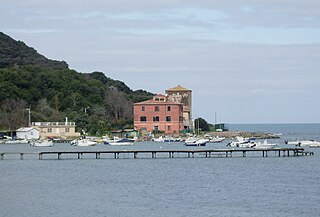
Baratti is a village frazione of the comune of Piombino in the Province of Livorno, with roughly only 15 residents.

Punta Ala is a frazione of the town of Castiglione della Pescaia, in the province of Grosseto, Tuscany, Italy. The small town with a population of 402 people lies at the bottom of the northern hillsides of the promontory of the same name. The coastal town is a popular summer seaside destination.

The Archaeological Museum of Populonia, opened in 2001 in the town of Piombino, Italy, contains artifacts from what was the ancient territory of Populonia during a period ranging from prehistory to late antiquity. The museum contains an active center of experimental archaeology with a focus on the processing of ceramics and stone.

The invasion of Elba, codenamed Operation Brassard, was part of the Italian campaign during the Second World War. The invasion was carried out from 17 to 19 June 1944 by Free French Forces supported by British and American ships and aircraft. According to the testimony of captured Germans, Allied activity had been observed on Corsica, thus the defenders were aware of the impending invasion 24 hours in advance. They resisted for two days before being given permission to withdraw to the mainland.
The archaeological area of Poggio del Molino is situated on the northern side of a headland that acts as a watershed between the beach of Rimigliano in the north, and the Gulf of Baratti in the south; to the northern border of the territory administered by the city of Piombino in the Italian Province of Livorno. The structure of Roman age spreads over a high plateau of about 20 m asl which dominates, in the west, the stretch of a sea between San Vincenzo and Elba and to the east, the metalliferous hills and plains of the Campiglia lagoon. The top of the hill is occupied by the beautiful Villa del Barone, built in 1923 by Baron Luigi De Stefano and Assunta Vanni Desideri, the daughter of Eugenio. From a paper of the 16th century, the "Bandita di Porto Baratti", and some archival documents we know that the Poggio owes its name to the mill which was a part of Torre Nuova, the building of coastal defense and a lookout built in the early sixteenth century by Cosimo I de' Medici, on the slopes of the promontory.
Isabella Appiani was Princess of Piombino from 1611 until 1628. Through her father, she was a descendant of Lorenzo de' Medici.
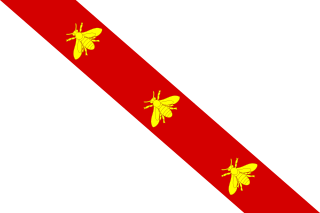
The flag of Elba was used during the period of stay of Napoleon Bonaparte as sovereign of the island of Elba, from 4 May 1814 to 26 February 1815. The flag, donated by Napoleon on his arrival on the island, was hoisted on the highest point of Portoferraio on the day of the landing of the emperor on the island. The original flag is kept in the Napoleon residence, Palazzina dei Mulini in Portoferraio. The meaning of the insignia chosen by the Emperor has long been, and continues to be, a matter of debate among historians.

The Appiani family was an Italian noble family, originally from Al Piano or Appiano, a now disappeared toponym identified with the modern La Pieve in the comune of Ponsacco. They held the principality of Piombino from the early 15th century until 1628.
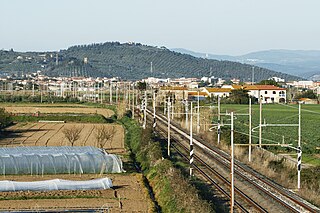
The Campiglia Marittima-Piombino railway line, also known as the Cornia Valley Railway is an Italian railway line that connects the junction at Campiglia Marittima with the port town of Piombino.



























